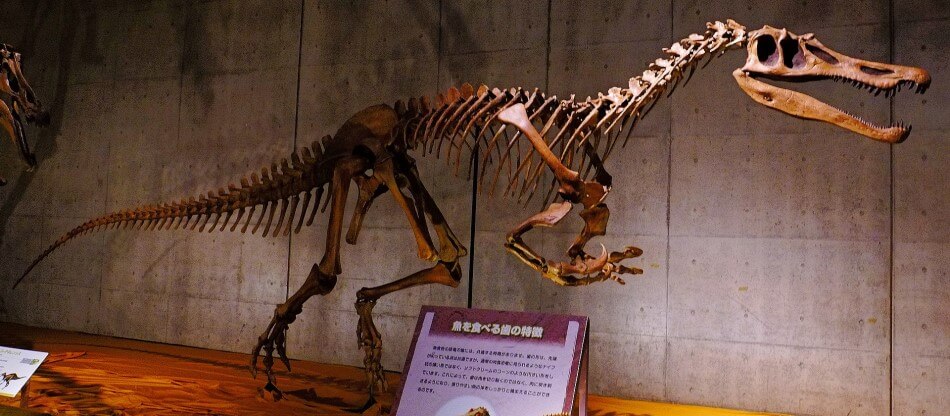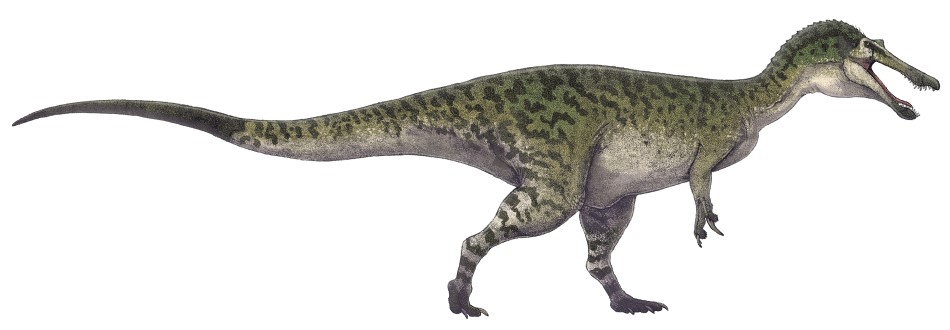Baryonyx Walkeri (said ba-ree-on-icks) is indeed a beast among dinosaurs. Its name means ‘heavy claw’ in Ancient Greek, with Walkeri being a tribute to its discoverer, William Walker. But a ‘heavy claw’ is just one of its amazing attributes, which is why the discovery of Baryonyx fossils is usually met with huge excitement from fossil hunters and palaeontologists around the world. This thin-nosed theropod was only discovered in 1983, but it has since helped dinosaur scientists to learn more about prehistoric life, missing details about other meat-eating predators, and how Baryonyx itself, fits into the evolutionary timeline of the dinosaurs.
1. Baryonyx was discovered in Surrey, England.
On a chilly January morning in 1983, William Walker, an amateur fossil hunter, came across something sticking out of the high walls of rock when exploring in Smokejacks brick pit in Surrey, England. He dug out what he realised to be a huge, curved fossilised claw. He immediately alerted London’s Natural History Museum who sent two very excited palaeontologists along to have a look. Over the next few weeks, they discovered more and more parts of what appeared to be a massive fossilised skeleton. The claw itself was more than 30cm along its curved edge and would have been covered in keratin (that’s what our fingernails are made of), so would actually have been even bigger!
Scientists investigating the fossils decided that this was a new type of Spinosaurus, bones of which had been found previously in Egypt in 1912. But this fantastic find was even better. This turned out to be the most complete skeleton of a meat-eating dinosaur ever found in the UK. And, although further fossils of Baryonyx have been found here and in Spain and Portugal, it has been seen as one of the most important discoveries ever since.
2. It lived on the coast of southern England.
Baryonyx lived from the early to the middle of the Cretaceous period, that’s 110 to 100 million years ago; the islands making up the UK had a very different look back then. What is now the south coast of England was actually connected to northern France by marshy land, full of winding rivers and swampy lagoons. There were no grasses as these hadn’t evolved just yet, but soft, spongey moss and tall, feather-leafed ferns helped to provide the perfect hunting ground for a beast like Baryonyx.

3. Baryonyx was a medium-sized theropod.
The fossilised skeleton found in Surrey may well have belonged to a juvenile, that’s a young Baryonyx, but palaeontologists think that this croc-like creature could have grown up to 4m tall and 7.5 to 10m long – and that’s considered to be medium-sized! It stood on two legs and had uncharacteristically long arms for a theropod. In fact, Baryonyx was very different to most other carnivorous dinosaurs in a number of ways.
4. Baryonyx included fish in its diet.
According to the Natural History Museum of London, no other theropods have been found to have had a piscivorous (fish-eating) diet. But, due to the presence of scales from the prehistoric fish Lepidotes, along with fossilised fragments of Iguanodon, in the stomach areas of Baryonyx discoveries, scientists have no doubt that fish would have been on the menu for these river-roving dinosaurs as well as meat.
5. It used its huge, hooked claw for fishing.
Although its very name emphasises the importance of its curvy claw, Baryonyx did not use its claw in the same way as other dinosaurs with such terrifying talons did. Famously clawed creatures such as Velociraptor and its Raptor family relations used their razor-sharp tools for ripping and slashing, but Baryonyx appears to have used its own for scooping fish from the rivers and streams of its native environment. The curved nature of its claw also meant that it did a much better job at keeping hold of slippery, wriggling fish than a straighter, more pointed claw shape would have allowed. For a good idea of how this would have looked, palaeontologists have highlighted bears as being a present-day example of how Baryonyx fished millions of years ago.
6. Baryonyx had a snout like a crocodile.
Another feature which has convinced experts of Baryonyx’s fishy fondness is the shape and length of its nose, or snout. Long and flat, it included a mouth which tilted upwards slightly to foil any fleeing fish. In fact, Baryonyx’s massive maw was very like those we see now in present-day crocodiles and alligators.
The beaky Baryonyx also had, what scientists call, a ‘rosette-shaped’ snout. This means that the end of its nose was slightly bigger than the rest, a bit like a small ball on the end of an empty toilet roll! And this is seen today in reptiles such as gharials, which look very similar to crocodiles and alligators and eat fish.
7. Baryonyx had more teeth than T-Rex.
With its long mouth and fishy diet, Baryonyx had very different dentistry to other meat-eating carnivores. Its teeth were small, serrated and cone-shaped, curving back towards the head to pierce and hook its panicking prey. And there were lots of them! In fact, Baryonyx had 96 teeth in total, and although nowhere near as impressive in size, that’s 36 more than its fellow theropod, the Tyrannosaur Rex!
8. It may have been able to swim.
Baryonyx had another major difference in its appearance. Its nostrils were set quite far back on its snout, not at the tip like most theropods. Palaeontologists think that this may show that it was able to swim, although it is still considered to be a land-dwelling dinosaur and not an aquatic one.
9. Baryonyx was related to Spinosaurus.
With a starring role in the Jurassic Park enterprise, Spinosaurus (said spy-no-sore-us) is a well-known, and well-feared, carnivore of the late Cretaceous period, living around 100 to 94 million years ago. It is presently recorded as being the biggest carnivore ever to have existed on Earth (not Giganotosaurus as claimed in Jurassic Park III), but it is clear from fossilised remains that Baryonyx has a very similar body shape, just smaller.
As mentioned, Spinosaurus was first discovered in Egypt in 1912, and was then given its official name in 1915. The fossils found didn’t form a complete skeleton but were considered to be the defining classification for many further discoveries of similar remains. Unfortunately, the original collection of Spinosaurus fossils was destroyed in an accidental bombing in Munich in 1944, leaving palaeontologists with no further investigating to be done. Until the discovery of Baryonyx.
The discovery of the almost-complete Baryonyx skeleton in 1983 helped scientists to fill in the gaps in their understanding of Spinosaurus and its close cousins, Suchomimus and Irritator. Much more is now known about all of these carnivorous creatures and many previously classified fossils are being named as Spinosaur types.

10. Baryonyx is still helping scientists.
In 2021, a new type of Spinosaur, Ceratosuchops (said seh-rah-toe-soo-chops) was discovered by professional fossil hunters on the Isle of Wight, off the south coast of England. This fantastic find, along with the Baryonyx remains from Surrey, has enabled experts to reconstruct the actual brain of a Spinosaur by creating virtual moulds using the cavities in the fossilised skulls. This has helped palaeontologists to further understand the ways in which it interacted with its environment and how it behaved.
Baryonyx Walkeri, coupled with advances in science and technology, has made a huge impact on dinosaur scientists knowledge and understanding of the meat-eating monsters which walked the shores of England, and those found much further away in the jungles and forests of Northern Africa and Brazil, millions of years ago. And there are even more Baryonyx facts to be found as new palaeontological discoveries are made every day. Maybe, one day experts will have found enough to recreate Baryonyx itself. But, thinking of the savage Spinosaurus in Jurassic Park – maybe not!
Baryonyx FAQs
What is the Baryonyx known for?
Baryonyx was known for it’s crocodile-like snout, many teeth (more than a t-rex), and it’s large hooked like cars. It’s the only dinosaur that’s thought to be piscivorous (fish-eating) diet. Due to the presence of scales from the prehistoric fish Lepidotes, along with fossilised fragments of Iguanodon, in the stomach areas of Baryonyx discoveries, scientists have no doubt that fish would have been on the menu for these river-roving dinosaurs as well as meat.
Can Baryonyx swim?
Baryonyx may have been able to swim. Its nostrils were set quite far back on its snout, not at the tip like most theropods. Palaeontologists think that this may show that it was able to swim, although it is still considered to be a land-dwelling dinosaur and not an aquatic one.
How many teeth does a Baryonyx have?
Baryonyx had 96 teeth in total, and although nowhere near as impressive in size, that’s 36 more than its fellow theropod, the Tyrannosaur Rex.
How tall is Baryonyx?
Palaeontologists think that the Baryonyx could have grown up to 4 meters tall and 7.5 to 10 meters long – and that’s considered to be medium-sized! It stood on two legs and had uncharacteristically long arms for a theropod
Did Baryonyx walk on all fours?
No, the Baryonyx stood on two legs and had uncharacteristically long arms for a theropod
